Displaying items by tag: Iconic Sign
At the entrance to Cork city is the iconic Port of Cork sign which should be retained when the site is redeveloped the Green Party has said.
A planning application, reports EchoLive.ie, has been lodged for Ireland's tallest building located at the Port of Cork buildings at Custom House Quay.
Tower Holdings are proposing a 34-storey skyscraper hotel that would reach approximately 140m in height.
If approved and constructed, it would become Ireland’s tallest building by a significant margin, outstripping the current tallest building, the 79m-high Capital Dock in Dublin.
The €140m project will also include retail units, cultural spaces, food and beverage businesses, office space, recreational areas, and a micro-distillery, which the developer says could create up to 800 jobs.
Below the hotel, the Bonded Warehouses will be occupied by a range of uses to complement the hotel including retail, restaurants, cafes, and gallery and cultural spaces, with a public promenade wrapping around the entire site.
The proposed distillery would be located at the tip of the site where both the north and south channels of the river Lee meet.
More on this story here.




























































